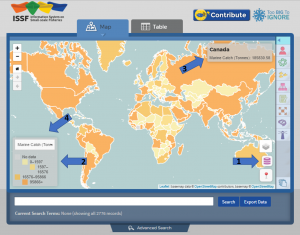TBTI is pleased to announce the launch of our Information System on Small-Scale Fisheries' (ISSF) newest dataset: “Country Statistics”!
This update provides ISSF users with an interactive choropleth map which gives a visual display of fisheries statistics at the country level. At this time, ISSF displays the following sets of data using the choropleth map: 1) Marine Catch (Tonnes), 2) Marine Catch ($), 3) Inland Catch (Tonnes), 4) Small-Scale Fisheries Subsidies ($) and 5) Proportion of Small-Scale Fisheries Subsidies vs. Large-Scale Fisheries Subsidies.
These new sets of data will allow ISSF users to visualize the amount of landings (tonnes) that small-scale fisheries contribute to their country. Due to the ecosystem diversity that small-scale fisheries (SSF) occur in, from the open ocean, lakes, rivers, to mangroves, and coral reefs, it is important to present both marine and inland catches to create the full picture of SSF's contribution. Since a majority of their catch is either retained for household consumption or is sold within local markets, SSF's landings play a vital role in sustenance and community viability. The numbers that you will see displayed are a representation of the hard work and livelihoods of thousands of small-scale fishers. The source of the marine catch data is the Sea Around Us project and the source for the inland catch data comes from FAO fisheries statistics.
The subsidy data is based on a study done by Anna Schuhbauer, a former PhD student with TBTI who has recently graduated from UBC. The study reveals that large-scale fisheries receive about four times more subsidies than their small-scale counterparts, with up to 60 per cent of those subsidies promoting overfishing. While SSF employ over 22 million people globally and directly support food security, of the estimated global fisheries subsidies of $35 billion (U.S.) in 2009, only 16 per cent was allocated to the small-scale fishing sector. The largest such subsidy is fuel subsidies, 96 per cent of which are given to the large-scale fisheries through marine diesel subsidies. Because of the high cost of purchasing and maintaining diesel motors, most SSF vessels run on gasoline, which is not as heavily subsidised. To find out more about the bottom-up analysis of the proportion of global marine fisheries subsidies to SSF, see the recent article by Schuhbauer et al. on 'How subsidies affect the economic viability of small-scale fisheries' and the accompanying media release.
Accessing the choropleth map on ISSF
Go to the ISSF webpage and then simply click on this icon"![]() " found near the bottom right corner of the map. Once the map has loaded it will display marine catches by default. Hovering your cursor over a country will then display its value in a box located on the top right of the map. You may also change the data that is being displayed by clicking on the drop-down menu found just above the legend. The map and legend will update to reflect those changes.
" found near the bottom right corner of the map. Once the map has loaded it will display marine catches by default. Hovering your cursor over a country will then display its value in a box located on the top right of the map. You may also change the data that is being displayed by clicking on the drop-down menu found just above the legend. The map and legend will update to reflect those changes.
Log onto ISSF, explore these new data layers and keep an eye out as more sets of data are released!
- Toggle country statistics on/off
- Legend displays range of value for selected data
- Display of country's value
- Drop-down menu contains interchangeable fisheries data
















